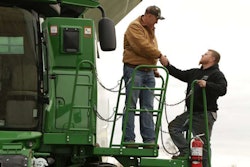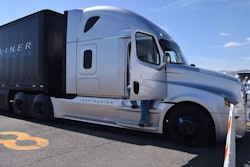A recent blog from WIRED criticizing the impenetrable software programs that run John Deere’s ag tractors has created quite a stir in the equipment community.
In a nutshell, the the author Kyle Wiens reports farmers are hopping mad that there are so many sensors and computers running these machines that you need the dealer to diagnose problems and maintain the equipment. You may own the tractor, but according to the article, the OEM owns the software that makes it run and you can’t hack it, tweak it or change one line of code.
Farmers, who like to hack, fix, tweak and repair stuff, hate this—or at least the two Wiens talked with hate it.
Wiens is the co-founder and CEO of iFixit, an online repair community and parts retailer known for their open source repair manuals and product teardowns. So he has a vested interest in open source software. Wiens thinks you should be able to tinker with the software that controls your phone as well as any other device or machine no matter if it’s a household appliance, an ag tractor or a $400,000 bulldozer.
At the heart of the problem is Digital Millennium Copyright Act, Section 1201, which claims the software codes that run all these sophisticated machine operations are protected by copyright laws. Without an exemption to the Act, many fear the automotive and equipment OEMs will have a monopoly on parts, maintenance and repairs.
“We want big brother watching out for us.”
There is a lot of similarity between diesel-driven ag equipment and construction machines. But when you talk to heavy equipment contractors and fleet managers—and I’ve talked to dozens about this over the last decade—you get a different opinion, often 180 degrees opposite of what the farmers Wiens cited and automotive enthusiasts are complaining about.
Business decisions, not emotional ones
For most contractors, pride of ownership takes a backseat to performance and productivity. Most of the software programs running these machines do exactly that—maximize productivity, eliminate downtime and minimize fuel consumption.
Additionally this software controls the complex exhaust emissions systems in this equipment which has cut pollution going out the exhaust stack by more than 95 percent in a decade. Tinkering with the emissions parameters on any modern diesel powered machine today is a serious violation of Environmental Protection Agency laws. It’s akin to dumping your used motor oil in the creek out back and will get you in just as much trouble if you’re caught.
A decade ago I would occasionally hear grumbling from some contractors about having to buy or lease software to do diagnostic test on machines. But with the rapid emergence of telematics data that argument seems to have vanished. Integrated into the software that controls the machines, the telematics systems today will often give you early warning of potential problems and thus prevent catastrophic and expensive failures.
RELATED >> Caterpillar’s predictive diagnostics will enable more “repairs before failure” in future telematics updates
And depending on the vendor and how you set it up, today’s telematics systems will let you check the health and operating parameters of any machine anywhere in the world from a web-enabled computer, tablet or smartphone. Telematics enabled machines will even call your phone if the sensors and software think something needs immediate attention.
Additionally, OEMs are using telematics to harvest the data coming off the sensors to improve the design and shorten the new product introduction cycle. Today, most major OEMs are collecting that information in real time resulting in an almost continuous round of improvements. And when there is a constant stream of telematics information coming off a machine, warranty claims get a lot more honest—on both sides.
Last but not least, the safety risks of tinkering with the software on a 40-ton dozer that can literally push a building off its foundation are so great that no contractor in his right mind is going to try it.
If there is any complaint about the telematics revolution it’s that today’s systems give contractors and equipment managers too much information.
One group that has more skin in this game than anybody is the Association of Equipment Management Professionals, a group heavy equipment technicians and managers. The average AEMP end-user member manages a heavy equipment fleet worth $157 million and wields an annual equipment acquisition budget of $16.5 million.
In an email dialogue with fellow AEMP members, Larry LeClair, a certified equipment manager and fleet manager for AJ Johns in Jacksonville, Florida, wrote that the resistance to OEM software copyright reflects, “the emotional attachment most people have for something they have bought, and uses old school thinking that it can last forever.”
Fleet managers like LeClair understand that heavy equipment is typically turned over every three to seven years. Owners typically factor in a buyback price or the residual valve into their ROI calculations. These are business decisions, not emotional ones. And no dealer (and I would imagine no contractor) would pay top dollar for a used piece of equipment if its software codes have been altered by the previous owner.
The AEMP has long held a philosophy that the best equipment management practices depend on what it calls the “equipment triangle,” a close working relationship with the end user, the distributor and the OEM. The combination of sophisticated software and telematics has made the dealers’ role more important since the dealer has the expertise to handle the software and the contractor does not.
A different idea of ownership
Last fall at its Asset Management Conference, AEMP put together a panel of fleet managers to discuss their experience with equipment telematics. When asked if he wasn’t concerned about “Big Brother” collecting and monitoring all his machine data, John Meese, senior director of heavy equipment at Waste Management flipped the question on its head.
“We want big brother watching out for us,” Meese said. “The question I would have is ‘why aren’t you watching our machines.’ I’m all for the dealer seeing all that we’ve got.”
Dave Gorski, certified equipment manager and shop administrator for K-Five Construction concurred. “We need all the eyes on the equipment we can get,” he said. “I will accept anybody who can help us by any means. They may see some of the things in the field that we may miss, and if they’re smart they’ll watch out for us in the field and make recommendations.”
Middle ground a must
Although the writer of the WIRED blog didn’t reach out to anybody with a dissenting opinion, there is some merit to his argument against what he calls the “slow creep of corporate product control.”
In discussing this issue, Deere pointed out to us that their copyright protection is just for the software in the computer of the machine, not on parts, maintenance and repairs. But what concerns me is that so many components and parts now have networked sensors that in the future if you don’t use an OEM part, the computer running your machine may not function.
I’m not accusing anybody (yet), but there is potential for OEMs to force customers to buy only OEM replacement parts in the future given that today’s sensors are so small, powerful, proprietary and networked into all the other machine systems. Whether this falls under the provisions of the DMCA remains to be seen, but if the DMCA is not amended to reflect this it could hurt the country’s vast network of aftermarket parts manufacturers and vendors on both the automotive and the heavy equipment side.
RELATED >> AEM/AEMP draft telematics standard released; enables unified reporting of mixed fleet systems
SEMA, the Specialty Equipment Manufacturers Association, is fighting for the exemption, and with good cause, noting that many of the improvements to automotive technology in the last 20 years have come from independent aftermarket manufacturers.
Last year the independent automotive shops and consumers won nationwide approval of their Right to Repair laws. Whether this right to repair translates into the heavy equipment arena remains to be seen. But the OEMs need to think long and hard about shutting out the aftermarket parts suppliers by putting controllers and software on parts that make it impossible to use anything by OEM factory-built components.
There are already networked sensors on windshield wipers for some models of cars. What happens if 10 or 20 years into the future the third or fourth owner of a machine can’t get something as simple as a windshield wiper because the OEM decided to quit “supporting” that model? What happens when they quit giving updates to the code that controls the tire pressure monitors, hydraulic cylinders or the ABS system?
Another reason heavy equipment OEMs shouldn’t make their machines too hard to repair is the residual value. What is the residual value of that machine if a potential second buyer in Mexico or Eastern Europe can’t fix it? Potentially far less than what that machine would command at auction if it were supportable anywhere in the world. And at many heavy equipment auctions today as many as half the buyers are from outside the United States.
When the used equipment market realized that many of today’s Tier 4 Interim and Tier 4 Final emissions compliant machines couldn’t be sold into less-developed countries with high-sulfur fuel, it punished the prices accordingly. Manufacturers were left scrambling to sell DPF-delete kits and other quick fixes to make those machines viable worldwide. Imagine what the market will do to the prices of machines that can only be maintained or repaired by authorized North American, European or Japanese dealers.
There should be a sweet spot between protecting the software that optimizes new machine performance and giving second, third and fourth generation owners a path to repairs that doesn’t require high tech software and or proprietary price gouging. If the industry doesn’t find this sweet spot, I’m sure the lawyers and the used equipment market will.












